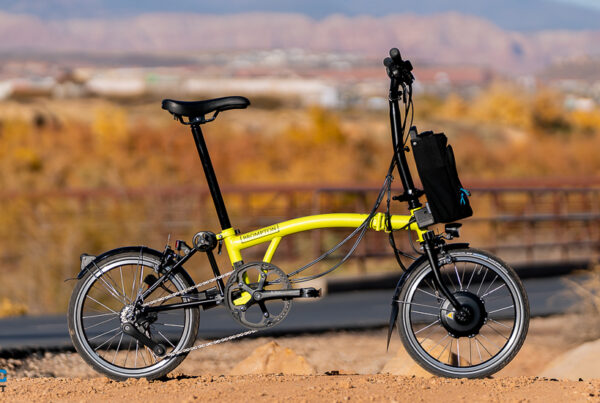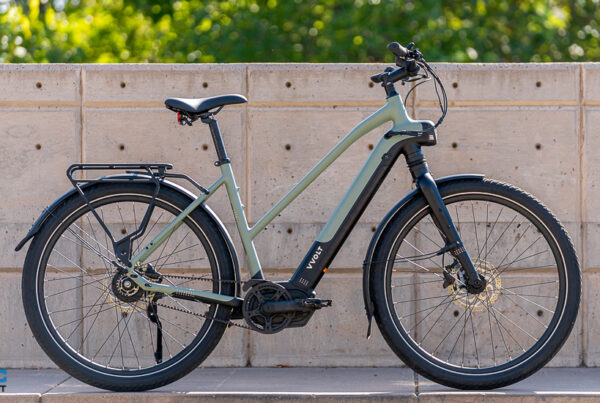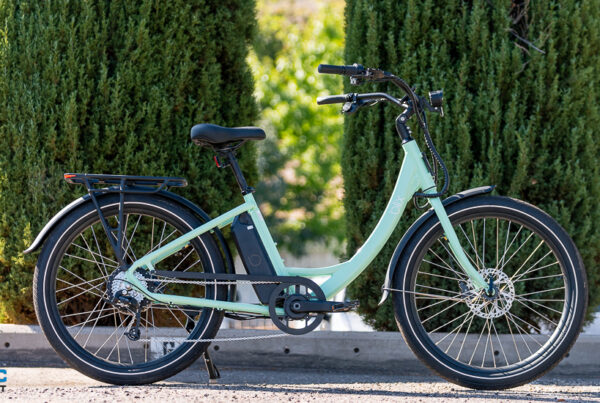Some links may be affiliate links. We may get paid if you buy something or take an action after clicking one of these.

New to the world of electric bikes? Welcome.
The bicycling world is going through a bit of a reckoning right now. Or maybe it’s growing pains; it’s hard to say.
Even before a pandemic drove everyone outside (and drove bike sales through the roof) the budding popularity of electric bikes had been attracting newcomers to bicycling in droves. E-bikes have democratized the cycling world, opening the door for people who previously wrote off the sport (and mode of transport) as a pastime of lycra-clad fitness enthusiasts. Bikes equipped with small motors and batteries are changing the shape of what is possible on two wheels and by who; making bicycling more accessible, less intimidating and flatly more fun for beginners and experienced riders alike.
The bicycling world is booming and we’ve got e-bikes to thank. So if you’re new here, welcome.
But with this new tech (and all these new people) has come a void of knowledge. E-bikes are complicated, and things like amperage, motor type and watt hours can be foreign concepts to the uninitiated. So, we wrote a guide to help with that.
This electric bike buyer’s guide will help you navigate the budding e-bike market and choose which bike is right for you. From commuters to cruisers and drive systems to laws, we’ll cover the basics of what you need to know before opening your wallet.
Want to jump to a specific topic? Here’s links to specific sections of this guide.
E-bikes 101: Understanding motors, batteries and drive systems
Since the first person tried to slap an electric motor on a bicycle in the late 1800’s, the core concept of an e-bike hasn’t changed much. It’s a normal bicycle (or sometimes a trike) with an added boost when a rider turns the pedals.
But there are some important things to know about e-bikes before shelling out your hard-earned cash. Let’s start with the most obvious components of an e-bike: the motorized drive system and the electronics powering it.
Here’s a breakdown of the basic components of an e-bike drive system:
- An electric motor, usually mounted in the front hub, rear hub or inside the bottom bracket of the frame (known as a mid-drive.) Each mounting point has specific purposes and can change the ride characteristics of the bike. A rear mounted motor, for example, is typically the torquiest and delivers power directly to the rear wheel; a mid-drive bike is better balanced and can more closely replicate the feeling of riding an analogue bicycle; and a front wheel motor, the rarest of the bunch, is typically reserved for cargo bikes or trikes, where mounting a motor in the back may not be an option.
- A battery, most commonly mounted on or in the front triangle of the bike’s frame. Among the most important features to consider on an e-bike, the battery quality and size determines how long you’ve got until your e-bike turns into a really heavy normal bike. A multitude of factors affects battery life, including battery size, a rider’s style, terrain and even weather.
- The controller dictates how your e-bike’s motor interprets input from the rider and accordingly applies power. Think of this as your e-bike’s brain: You apply pressure to the pedals or twist the throttle, and the controller tells the motor to apply power at a (hopefully) safe and proportional rate.
- A speed, cadence or torque sensor is a device that detects pedaling on a pedal assist e-bike and tells the motor to kick on. Some bikes will come with a combination of these sensors, but there are distinct differences in how each works
- A speed sensor engages the motor relative to the bike’s speed. So, the higher the speed the higher the output from the motor, even when you’re going downhill.
- A cadence sensor detects movement at the bike’s cranks, and engages the motor when you start pedaling. In some cases, bikes are programmed to adjust the power output from the motor based on pedaling speed.
- A torque sensor, the most refined of the bunch, uses a strain gauge to measure how much force a rider is putting into the pedals. The motor will increase or decrease its output relative to how hard you pedal. This type of sensor typically engages quickest and smoothest.
Those four things added together (and bolted onto a bicycle frame) are the core ingredients of an e-bike and constitute its non-human drive system.
How do you control an e-bike motor?
There are two primary ways an e-bike rider can engage their bike’s motor.
The first, and the most common, is simply by pedaling the bike. This type of motor control, called pedal-assist or a pedelec (short for “pedal electric bicycle”), is where an e-bike’s motor responds to force applied at the pedals, adding an additional boost to a rider’s natural pedaling ability.
Depending on the bike, motor and how the controller is programmed, this added boost can feel like a relatively gentle compliment to your natural pedaling ability, or, in the case of more powerful e-bikes, like you’re on a small pedal-powered rocketship.
Some e-bikes also include a user-controlled throttle, allowing a rider to engage the motor on demand. This is the second way some e-bike’s give riders control over a bike’s motor. The throttle is typically a thumb-controlled lever mounted on the handlebar, capable of controlling the motor while coasting or while at a complete stop, similar to a moped. An e-bike equipped with a throttle typically also has pedal-assist capabilities, though there are some exceptions that are throttle only.
Where can (and can’t) I ride my e-bike? The three-class system and why it matters
E-bikes, at their core, are designed to give people the ability to ride their bicycle further, faster and easier, regardless of their expertise riding a bike or their physical fitness.
But e-bikes do present a bit of a conundrum. On one hand, they effectively are democratizing the cycling world, making bikes more accessible to more people and for more uses. But on the other hand, their increased speed and power presents a safety problem, especially in areas like mixed-use paths and trails with heavy pedestrian traffic.
These safety concerns have led to the development of the three-class system for regulating e-bike access, which places restrictions on certain types of e-bikes based on their motor operation, wattage and maximum assisted speed. About half of U.S. states have adopted e-bike laws and regulations based on the three-class system, and bike advocacy organizations like PeopleForBikes are pushing model legislation centered on the classes. Europe uses its own variation of the class system which is more widely adopted than what you’ll find in the U.S.
The U.S. classes are:
- Class 1: Pedal assist only and the motor cuts off at 20 mph (you can pedal yourself to quicker speeds). These are typically allowed anywhere you can ride a non-motorized bicycle.
- Class 2: The motor is controlled by a throttle that can be operated when you’re not pedaling. The motor on these also cuts off at 20 mph and they’re typically allowed anywhere you can ride a non-motorized bicycle.
- Class 3: The motor on a Class 3 e-bike will power you until 28 mph before it cuts off, but it can only be operated to that speed with pedal assistance. This class of e-bike can also include a throttle, but that throttle is limited to 20 mph and you’ll have to pedal to make the motor go any faster. These must also be equipped with a speedometer and are typically limited to use on road-adjacent bike lanes and in roadways themselves.
All classes limit the bike’s motor to 750w sustained, almost exactly one horsepower. Though the three class system is not universal in the U.S. (yet), most e-bike manufacturers and sellers have subscribed to this system.
E-bikes 102: Torque, watts, watt hours, volts, Et al.
By now, you’ve got the basics of what makes an e-bike an e-bike and you’re ready to dive further into the weeds.
Like a car, the size, strength and power of an e-bike’s motor and battery can vary greatly from model to model. Even changing one component in the drive system can drastically change how it performs.
The below list of variables and terms are how e-bike manufacturers describe their motor and battery systems. By grasping them, you can get a rough picture of how a given bike might perform (at least on paper).
- Torque is the rotational force produced by the motor, usually measured in Newton meters (Nm). On an e-bike, torque is particularly important for acceleration and going up hills.
- Volts are, in essence, a measure of electrical pressure inside a battery. The measure is commonly explained using this analogy: If a battery is a water tank, the voltage would be the water pressure built up inside. The higher the pressure inside the tank (or volts inside a battery), the quicker water (electricity) will flow from the tank (battery) and at higher volumes. To sum it up: The higher an e-bike battery’s voltage, the more power is available to the motor and quicker.
- Amps (short for ampere) is the basic unit used to measure electrical current. What this describes is the constant rate of flow of electricity out of a battery. The higher the amperage, the more electricity is flowing.
- Amp hours: Going back to the water analogy, amp hours describe the size of the water tank. The larger the tank — or, in the case of e-bikes, the larger the battery — the more water there is for use. This unit of measurement tells you exactly how much amperage a battery can sustain for one hour. For example, a 10Ah rated battery can expend 10 amps of power in an hour before it’s drained. That rate can also be accelerated or decelerated, so the same battery can expend 20 amps in a half-hour or 5 amps over two hours.
- Watts (often shortened to just a “w”) are to e-bikes what horsepower is to cars. It’s a measure of how much power the motor produces. The three-class system in the U.S. allows e-bikes to sustain up to 750w, though many motors can produce short bursts much higher than that. For context, a typical professional road cyclist might average between 300w and 400w during a race, so e-bike motors are plenty strong.
- Watt hours (Wh for short) describes how much energy is available in a battery for exactly one hour. A battery rated for 480Wh, for example, is going to have a battery capable of producing 480 watts for exactly one hour before it runs out. Combine that with a 750w motor, the legal maximum in the U.S., and that same battery would be able to run the motor at max throttle for about two-thirds of an hour before it runs dead.
So why do these terms matter? Because added together and applied to specific e-bike drive systems, the above concepts can help you get an idea of what a bike’s motor and battery are theoretically capable of.
But, don’t put too much faith in a bike’s spec sheet. Measures like amp hours and watt hours can be deceiving, and variables like temperature or the number of hills on your ride can wildly affect the performance of a bike’s motor and battery. When it comes to truly knowing how a bike will perform, there’s no substitution for actually riding it.
The most important part: How to choose the right e-bike for you
At the end of the day, an e-bike is just like a normal bike. It rolls, it pedals and it takes you where you want to go.
So just like buying a non-motorized bike, there is one question you must answer before buying that is paramount to all others: What do you want to do with the bike?
Seriously. Think long and hard on this one. Salespeople and bike brands will tell you all day they’ve got a bike that can handle anything, but the truth is there is no one bike that can do it all. There are examples where one bike can shine across multiple categories — a fat-tire folding e-bike, for example, makes for a nice urban commuter that can also handle some light off-road use. But it won’t make for a good cargo bike and it’s not going to keep pace with a lightweight electric road bike, no matter how big a motor you put in it.
In total I’ve spent more than a decade turning wrenches and slinging bikes at shops across the American southwest and this, by far, is the most important question I asked when a prospective bike buyer walked in the door. It’s also one of the toughest to answer.
Many first-time e-bike buyers won’t know the different categories of bikes, or why it might be worth spending a bit more (or less) money to get something actually capable of accomplishing their goals. If you fall in this group, or just feel a little lost in the broad world of e-bikes, here’s a breakdown of the different categories of e-bike and what they’re for:
- Step-thru frame e-bikes More of a frame style and less of an e-bike type, a step-thru frame e-bikes features a low-slung frame that is easier to mount. This style is typical of cruiser and commuter e-bikes, and is a friendly design for people with limited hip mobility, back issues or those that might need to wear work clothes when they ride.
- Folding e-bikes Popular in Europe and a novelty in the United States, folding e-bikes are good for people who want to store the bike in a compact space like a trunk or RV, or who might need to stow their bike in a cramped office space. Like the name suggests, a folding e-bike literally folds up and, in some cases, becomes quite small. Though comfortable for a full-size adult, the bikes are physically smaller and usually feature smaller diameter wheels — which can change the handling characteristics and your riding position.
- Fat-tire e-bikes Fat-tire e-bikes are the monster trucks of the bike world. As the name suggests, the tires are wider than usual — typically about 3 to 4 inches wide. This style of bike was developed to ride over snow with ease, but it can also handle sand and other variable terrain quite well. The fat tires are confidence inspiring, but the extra rubber amounts to more rolling resistance and rotational weight, so they’re not particularly energy efficient.
- Cargo and utility e-bikes If you thought an e-bike could never replace your minivan, think again. Cargo and utility e-bikes are pedal-powered behemoths capable of ferrying hundreds of pounds of cargo and people. They’re also the quirkiest of the e-bike family (which is saying something after seeing some folding bikes) and come in many different configurations; almost all of which have a wheelbase long enough to fit a cargo area fore or aft of the rider.
- Cruiser e-bikes From low and slow on the Mission Beach Boardwalk to quick and comfy on the bike path, cruiser e-bikes blend classic styling with e-bike efficiency. But before e-bikes became popular, I’d be dishonest if I didn’t acknowledge the number of would-be cruiser buyers I talked out of purchasing this style of bike. Why? Because they’re so dang inefficient to pedal. That all changed when companies started pairing the cruiser style with e-bike drive systems. Now, with the brunt of the pedaling power handled by a motor, the comfort and laid-back styling of these bikes can really shine.
- Electric mountain bikes (eMTBs) Exactly as the name suggests, electric mountain bikes are the technical off-road iteration of e-bike. Designed to handle drops, steep climbs and rock gardens with a little added boost, eMTBs are surging in popularity. The motors are specially tuned to handle the punchy, torquey type of power required to clear steep hills and obstacles. There are also more lightweight variations as companies like Specialized and Orbea target e-bike riders who want a more nimble and natural ride. These are typically Class 1 e-bikes, though you can find some Class 2 iterations.
- Electric road bikes “Superbike” is a term thrown around often these days in the bicycling world, probably too often. But in the case of high-end electric road bikes, superbike might be exactly the right way to describe them. These are the Ferraris of the bicycling world and at their highest price points they feature the exact same technology and aerodynamic advantages of Tour de France winning race bikes, but with a small electric motor melded into the bottom bracket. In short, they’re very fast (and very fun), though you’re still going to have to pedal hard to get the most out of them. These are almost exclusively Class 1 e-bikes with smaller motors and batteries.
- Electric gravel bikes The newest iteration of e-bike (and, really, the newest iteration of bicycle in general), electric gravel bikes are performance-oriented rigs designed around pedaling efficiency and speed on gravel roads. They’re typically drop-bar bikes that closely resemble their road bike brethren, but with a few key differences like increased tire clearance and brakes that can operate well in mud and dust. Motors on these are typically small and refined to compliment a rider’s natural pedaling, rather than overpower it. Expect to still work on one of these, as they are also primarily Class 1.
Summary
Again, think long and hard about what you want to do with your e-bike. Do you want something that can fold up and easily fit in your RV’s underfloor storage compartment? Something reliable and fast (Commuter Electric Bikes) to get you to and from work? Are you the type to don lycra riding gear and knock out 60 miles on a Saturday morning, but want a little boost to compliment your pedaling?
If this sounds like a lot to consider, or just unrealistic considering so many bike brands are direct-to-consumer, we’re here to help. ElectricBikeReport.com’s experienced staff (About Us) of e-bike enthusiasts, riders and racers puts bikes thought their paces on our home roads, trails and paths in southwest Utah to give you a clear picture of how bikes perform in the real world.
We follow industry news (Most Recent News) to keep tabs on latest developments in e-bike technology; suss out the best e-bikes across all categories; and make content that will teach you how to maintain your e-bike (or when it’s time to take it into a shop).
So if you’re new here, welcome to the world of e-bikes. We’re happy you’re here.
Related
Reader Interactions

Source link








